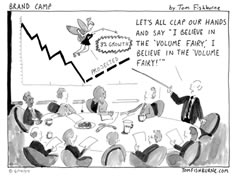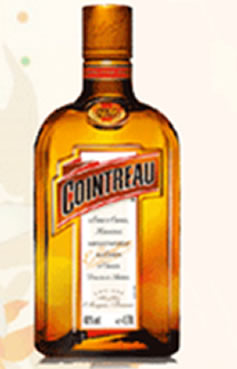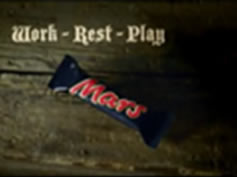Leading Brands Out of Decline - They Don't Bounce
領導品牌走出衰退-它們不會自己復原
原文網址: Link
摘要:品牌的重建必須做到由內而外、從產品、包裝到傳遞訊息的全面重建,且呈現的是圓滑的U形而非V形的復甦。
我們常和行銷總監一起努力嘗試扭轉品牌的衰退。通常這些品牌面臨了數年的銷售額下降,要讓它們再度成長真的是一大困難。
在許多情況下,都希望這些品牌能夠從谷底反彈,由衰退一路返回成長。這在另一位卡通天才Tom Fishburne的圖畫中顯現。
一個很殘酷的現實是:領導一個品牌走出長期衰退就像是機長駕駛著一架往地面俯衝的飛機。一開始你必須漸緩衰退的速度以避免墜落,接著你必須穩固品牌;唯有如此你才能使品牌重新攀升。所以品牌由衰退走向成長的形狀傾向於被塑造成U形而非V形。
這裡有些品牌從扭轉中學到的教訓。
1.弱品牌遭受多重的失敗
很抱歉,這邊要用另一種隱喻:弱品牌通常真的是奄奄一息;它們缺乏一個清楚且一致的訊息傳遞方式。包裝的設計可能退流行了、產品常被忽略,或是降低品質以減低成本;行銷支出被削減。由於缺乏零售商和公司銷售人員的支持,品牌也許無法在店裡被徹底執行。
這意味著搶救品牌必須各方面同時行動。要迅速。你必須完全的重建品牌。
2.內部承諾很重要
我從以橘色為精神的君度橙酒,看到單單只是重建公司內部對於品牌的信心,就已經十分有效。過去25年來他們以一年3%的速度緩慢且持續的衰退。3%聽起來不糟,但是長期累積下來已經侵蝕了一半的品牌銷售額。
為品牌的傳遞與包裝所設計的重建計畫需花費時間。全球品牌主管Olivier Charriaud,聰明的採取了內部重建的行動。他讓銷售人員相信這個品牌是有未來的。這接著意味銷售團隊會更有信心將品牌推銷給零售商。這已足夠穩定品牌,甚至創造了1%的銷售成長。雖然不多,卻是歷經25年的衰退後首次有進展。
3.降低期待心理
一旦你的重建策略被認同,許多和你一起工作的資深經理會期待有立即的成效。如果銷售額沒有立即的反應,他們可能感到不耐煩並開始質疑你的策略。我的建議是盡可能的將情況形容的糟糕一點,提醒他們目前品牌的情況有多麼地岌岌可危。(假設你在這方面已經有一段時間的經驗了!)並且解釋穩定品牌的必要性,然後讓它成長。讓他們想想U形而非V形的復甦。根據經驗,你可以照著以下計畫:(雖然還是要依品牌的糟糕情況而定)
-重建後的頭6~9個月:減緩衰退
-其次6~9個月:穩定
-重建後18個月:重返成長
4.記住出名的原因,並重新賦予活力
衰退中的品牌通常在某些階段是成功的,但往往因為偏離了成功的模式才導致衰退。這就是為何回頭去看在定位及行銷上,是什麼原因讓該品牌有名會有所幫助。 接著的辦法是刷新這些品牌屬性和特質以跟上潮流。一個很好的例子是英國巧克力品牌Mars在1980和1990年代使人耳目一新的標語「工作、休息和娛樂」,它非常的成功。
總結來說,讓品牌從衰退中翻身是艱難的,準備好做長期的奮戰、計畫U形而非V形的復甦。當你真的要重建品牌,就要做到包含產品、包裝、傳遞訊息及承諾的全面重建。
We often work with marketing directors trying to turn round brands in decline. Often these brands have suffered from several years of falling sales. And its one hell of a job to get them growing again.
Hoping that these brands will "bounce back", from decline straight back to growth, is in most cases wishful thinking. This is shown by another bit of cartoon genius from Tom Fishburne below.
The harsh reality is leading a brand out of long-term decline is like being the pilot of a plane dive bombing to earth. First you to have to slow the rate of decline to avoid crashing. Then you have to stabilise the brand. Only then can you start to climb again. So, growth tends to be shaped like a "U", not a "V".
Here are some hard-learnt brand turn-around lessons.
1. Sick brands suffer from multiple organ failure
Apologies for another metaphor. Sick brands are often really sick. They lack a clear and consistent communication campaign. The pack design may be out of date. The product has often been neglected, or even reduced in quality to cut costs. Marketing spend has been cut. And the brand may be poorly executed in store, owing to lack of support from retailers and the company's own sales force.
This means that brand rescue requires simultaneous action on all fronts. Fast. You need a total re-launch of the brand.
2. Internal engagement counts for a lot
Just re-establishing internal belief in the brand can be highly effective. I saw this on Cointreau, the orange-based spirit. It had been declining slowly but surely by about 3% a year, for 25 years. 3% doesn't sound too bad. But over such a long period this ate away half the brand's sales.
The re-launch plans created for the brand's communication and packaging took time to get to market. The Global Brand Director, Olivier Charriaud, made the smart move of starting with an internal re-launch. He convinced the sales force that the brand had a future. This is in turn meant the sales team were more confident in promoting the brand to retailers. And this was enough to stabilise the brand and even create growth of 1%. Not much. But progress after a quarter of a century of decline.
3. Manage expectations – down
Most senior managers you work with will expect pretty much immediate results once your re-launch strategy is agreed. If, as is likely, sales don't respond immediately, they will probably get impatient and start to challenge your strategy. My advice is to paint as dark a picture as possible. Remind them how dire the brand's situation is (assuming your have been around for a short while!). And explain the need to stabilise the brand, then get it growing. Get them thinking about a "U" not "V" shaped recovery. As a rule of thumb, you could plan for the following (though this depends on how sick the brand is):
- First 6-9 months after re-launch: slower decline
- Second 6-9 months: stability
- 18 months after re-launch: return to growth
4. Remember and refresh what made you famous
Brands in decline have often been successful at some point. Often decline is caused by walking away from this success model. This is why looking back at what made a brand famous can help, both in terms of positioning and marketing mix. The trick is then to refresh these attributes and brand properties to bring them up to date. A good example is Mars in the UK refreshing the "Work, Rest and Play" slogan that worked so well back in the 1980's and 1990's.
In conclusion, turning round brands in decline is tough. Be ready for a long, hard slog. Manage expectation to plan for a "U" not a "V" shaped recovery. And when you do re-launch, make it a total re-launch, covering product, pack, communication and engagement.



